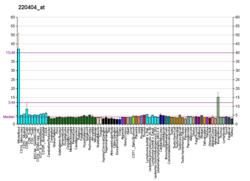G-protein coupled receptor 97 also known as adhesion G protein-coupled receptor G3 (ADGRG3) is a protein that in humans is encoded by the ADGRG3 gene.[4][5][6][7] GPR97 is a member of the adhesion GPCR family.[8][9] Adhesion GPCRs are characterized by an extended extracellular region often possessing N-terminal protein modules that is linked to a TM7 region via a domain known as the GPCR-Autoproteolysis INducing (GAIN) domain.[10]
GPR97 is expressed in human granulocytes and endothelial cells of the vasculature as well as in mouse granulocytes, monocytes, macrophages, and dendritic cells.[7]
- ^ a b c GRCm38: Ensembl release 89: ENSMUSG00000060470 – Ensembl, May 2017
- ^ "Human PubMed Reference:". National Center for Biotechnology Information, U.S. National Library of Medicine.
- ^ "Mouse PubMed Reference:". National Center for Biotechnology Information, U.S. National Library of Medicine.
- ^ Fredriksson R, Lagerström MC, Höglund PJ, Schiöth HB (Nov 2002). "Novel human G protein-coupled receptors with long N-terminals containing GPS domains and Ser/Thr-rich regions". FEBS Letters. 531 (3): 407–14. doi:10.1016/S0014-5793(02)03574-3. PMID 12435584. S2CID 7449692.
- ^ Kuźnicki J, Kuźnicki L, Drabikowski W (Jan 1979). "Ca2+-binding modulator protein in protozoa and myxomycete". Cell Biology International Reports. 3 (1): 17–23. doi:10.1016/0309-1651(79)90064-X. PMID 222487.
- ^ "Entrez Gene: GPR97 G protein-coupled receptor 97".
- ^ a b Hamann J, Aust G, Araç D, Engel FB, Formstone C, Fredriksson R, Hall RA, Harty BL, Kirchhoff C, Knapp B, Krishnan A, Liebscher I, Lin HH, Martinelli DC, Monk KR, Peeters MC, Piao X, Prömel S, Schöneberg T, Schwartz TW, Singer K, Stacey M, Ushkaryov YA, Vallon M, Wolfrum U, Wright MW, Xu L, Langenhan T, Schiöth HB (Apr 2015). "International Union of Basic and Clinical Pharmacology. XCIV. Adhesion G protein-coupled receptors". Pharmacological Reviews. 67 (2): 338–67. doi:10.1124/pr.114.009647. PMC 4394687. PMID 25713288.
- ^ Stacey M, Yona S (2011). Adhesion-GPCRs: Structure to Function (Advances in Experimental Medicine and Biology). Berlin: Springer. ISBN 978-1-4419-7912-4.
- ^ Langenhan T, Aust G, Hamann J (May 2013). "Sticky signaling--adhesion class G protein-coupled receptors take the stage". Science Signaling. 6 (276): re3. doi:10.1126/scisignal.2003825. PMID 23695165. S2CID 6958640.
- ^ Araç D, Boucard AA, Bolliger MF, Nguyen J, Soltis SM, Südhof TC, Brunger AT (Mar 2012). "A novel evolutionarily conserved domain of cell-adhesion GPCRs mediates autoproteolysis". The EMBO Journal. 31 (6): 1364–78. doi:10.1038/emboj.2012.26. PMC 3321182. PMID 22333914.


